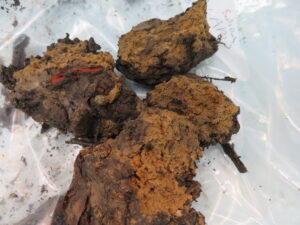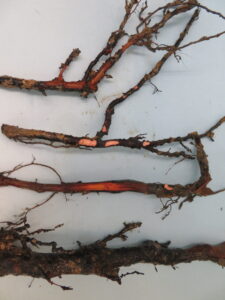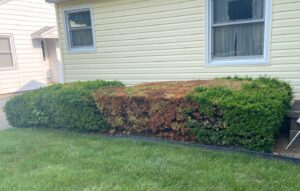Yews are widely used as foundation plantings in many areas and are valued for their dark, evergreen foliage. The most widely used landscape yews are Japanese yew (Taxus cuspidata) and Taxus x media hybrids, such as Hicksii or Wardii Yew.
While few diseases and insects attack yew, there are a few problems to watch for. The most common problem we find on yew is root rot due to poor soil drainage. In heavy clay soils with poor internal drainage, the soil may stay saturated for long periods (Figure 1), leading to root decay and loss of root function. Soggy soils also provide the right conditions for root rot disease caused by the soil-borne water mold Phytophthora (Figure 2).
- Figure 1. Heavy clay soil like this prevents drainage and promotes root rot.
- Figure 2. These yew roots have root decay and few fine feeder roots as a result of poor drainage and Phytophthora root rot.
You can do a soil percolation test to check for drainage, or just observe how long soil stays wet after a rain to get an idea of whether soil drainage may be affecting your yew. To diagnose Phytophthora root rot a root sample must be submitted to a diagnostic lab, where rapid dipstick type tests and isolations to check for the pathogen can be done. Results take about 3-5 days in most cases. More information on Phytophthora disease is available in our free Extension publication: https://www.extension.purdue.edu/extmedia/BP/BP-215-W.pdf
Another soil-related problem affecting yew may be soil pH. Taxus prefers soil between pH 6.0 and 7.0 and most soils in Indiana are in that range, however, if your taxus is yellowing or showing other symptoms of nutrient imbalance, it may be worth getting the soil checked for pH and overall nutrient levels at a commercial lab.
Roots may also be damaged by the grubs of black vine weevil. Look for notched areas on the edges of needles (Figure 3), and check roots for areas that appear eroded. This Purdue Plant Doctor article has more information on identification and management: https://www.purdueplantdoctor.com/factsheet/tree-300
- Figure 3. Yew needles showing notched edges caused by feeding by black vine weevil. Photo by John A Weidhass, Virginia Polytechnic Institute and State University. Bugwood.org.
Another stress factor that may affect yew is the practice of shearing into a tight hedge (Figure 4). There are many examples of healthy yew hedges kept in a formal style by shearing, but shearing does cause stress and if plants are affected by root rot, poor drainage, or root-feeding insects, the combination of problems may lead to dieback and decline. Tightly sheared hedge plants often have living green foliage only in a shallow outer layer a few inches deep, while the inner core of the hedge is typically vacant of needles due to shading out, so they have fewer nutrient reserves to draw on when stressed. Check out this site for suggestions on better pruning practices for conifers: https://www.canr.msu.edu/news/pruning_evergreen_shrubs
- Figure 4. Yew hedge in decline, sheared in a tight box pattern.
If you have unexplained dieback on yew, please consider sending photos and submitting samples to the Purdue Plant and Pest Diagnostic Lab.



